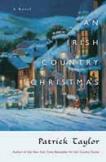Back in the Old Country
At one point in James Joyce’s classic story “The Dead,” Miss O’Callaghan comments, “I think Christmas is never really Christmas unless we have the snow on the ground.”
“The Dead” may indeed be set during the Morkan sisters’ famous annual holiday celebration, but it is no “Irish Christmas story,” at least as that phrase has come to be understood in publishing circles.
In recent decades, such acclaimed writers as John B. Keane, William Trevor and John McGahern have seen their works collected in volumes of “Irish Christmas” stories. These are generally not works about mortality, paralysis and the fleeting nature of earthly love (as Joyce’s story was), but instead about the idiosyncrasies of Irish (often village) life at a heartwarming time of the year.
Patrick Taylor’s third “Irish country” novel fits neatly into the non-Joycean category of colorful Irish Christmas tales. So neatly, in fact, that the popular Irish memoirist Alice Taylor (no relation, beyond the thematic) released a nostalgic book of the same name about a decade ago.
Born and raised in County Down, Patrick Taylor worked as a rural doctor before writing the best-seller An Irish Country Doctor, set in the fictitious village of Ballybucklebo. The titular main character was the reliably gruff yet irrepressibly soft-hearted Fingal Flahertie O’Reilly, who has taken the skilled yet timid young physician Barry Laverty under his wings.
We caught up with the duo again in Taylor’s follow-up An Irish Country Village.
In both books, Laverty, O’Reilly and a handful of likeable locals fall ill, recover, gossip and scheme, such as when they prevent a loathsome politician from closing down a beloved pub.
Along the way, the taciturn Fingal bares his romantic wounds, while Barry overcomes local skeptics, then falls in love with an independent-minded woman, with whom he must maintain a long-distance relationship after she heads to school in England.
Taylor’s vivid recreation of village life is certainly part of his wide appeal. The language and customs he depicts are charming, though his characters are never simply odd or exotic creatures. Equally fascinating (as Taylor notes in an Afterword) is that, while this may be Northern Ireland in the 1960s, little is said and even less is seen of political or religious conflict.
In Ballybucklebo “there was no sectarian strife,” Taylor writes in AnIrish Country Christmas, later adding that both “the Protestant and Catholic groups would come together for important functions like the upcoming annual Christmas party.” Ballybucklebo is “different from impersonal Belfast. Here people knew each other, were ready to help out, and didn’t throw older folks on the scrap heap.”
If Taylor’s Northern Ireland is fantastically idyllic, it is also hard to resist. Of course, readers should not come to these books expecting much in the way of political or psychological complexity. For a moment, in the new novel, Barry is tempted by another woman. And yet, though the book weighs in at nearly 500 pages, Taylor sets the situation straight with ruthless efficiency. Similarly, when a new doctor sets up shop in Ballybucklebo, we immediately know what we are meant to feel about him. The reader’s affection for Dr. O’Reilly, Dr. Laverty and their tart-tongued but loveable maid, Kinky, is never meant to be questioned. AnIrish Country Christmas culminates in the Christmas party, where yet another scheme has been hatched to help a needy mother and where Barry just might receive a wondrous Christmas surprise.
At a time when Irish fiction is moving with almost reckless abandon into the post-political 21st century, dabbling in the avant-garde, the gothic and other challenging genres, Patrick Taylor is unapologetically nostalgic. His sharp eye for the details of Irish village life has proven to be a hit with those who share this sentiment. If, indeed, there is a hunger among readers for such material, then An Irish Country Christmas is quite a holiday feast.
This article also appeared in print, under the headline “Back in the Old Country,” in the December 22, 2008, issue.








